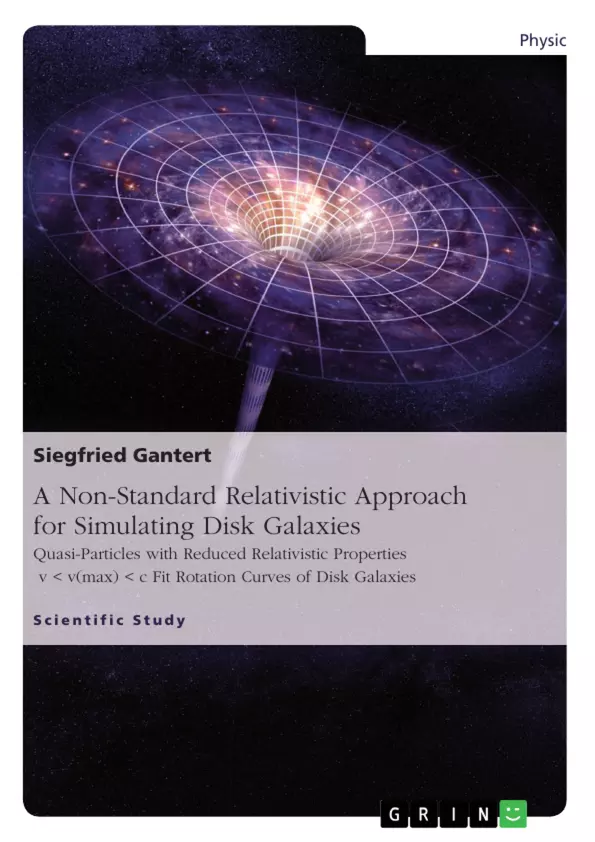In the present work, the gravitational discrepancies observed in disk galaxies are explained using a new relativistic theory beyond the standard model of physics. It assumes the existence of bosonic quasi-particles of a scalar field, which reach different relativistic velocities v < v(max) < c depending on her effective mass.
The magnitude of the limit velocity v(max) is derived from a hypothetical non-singularity condition of a quasi-particle at the velocity limit. Remarkably, it turns out that a good fit of the rotation curves is usually achieved by a relativistic velocity distribution of a galaxy-specific quasi-particle, where the maximum rotational velocity at the edge of a disk galaxy is approximately equal to the limit velocity v(max). From the relativistic velocity distribution a galaxy-specific halo with limited mass and finite size can be derived. The way dark matter can be characterized with the new approach suggests that entanglement and quantum correlation of quasi-particles plays a crucial role in the formation of a dark matter halo. To verify the model, 12 representative galaxies were selected from the SPARC data set [astroweb.cwru.edu/SPARC/] and evaluated according to the new relativistic model using the least squares regression method. A comparison of the obtained data with the empirical law of the radial acceleration relation shows high agreement. The SBM theory, which is based on a modification of special relativity theory, is applied here as a first-order approximation for bosonic quasi-particles in the asymptotic flat space of disk galaxies.
Inhaltsverzeichnis (Table of Contents)
- Introduction
- Theory
- SBM-model
- Speed limit of bosonic quasi-particles
- The modified Maxwell-Jüttner distribution for quasi-particles
- Results
- SPARC data set and fitting rotation curves with the SBM-model
- Simulation of dark matter halos with the SBM-model
- SBM-model and the Radial Acceleration Relation (RAR)
- Scaling relations
- Discussion
- Conclusion
- Acknowledgement
- References
- Appendix
- Phase boundary velocity
Zielsetzung und Themenschwerpunkte (Objectives and Key Themes)
This work aims to explain the gravitational discrepancies observed in disk galaxies using a new quantum gravitation theory beyond the Standard Model of physics. It proposes the existence of bosonic quasi-particles with different relativistic velocities, where the limiting velocity is derived from a hypothetical non-singularity condition. The work then investigates the relationship between the limiting velocity and the observed rotation curves of galaxies.
- The existence of bosonic quasi-particles with different relativistic velocities.
- The role of entanglement and quantum correlation of quasi-particles in the formation of dark matter halos.
- The relationship between the SBM-model and the observed rotation curves of galaxies.
- The application of the SBM-model to understand the Radial Acceleration Relation (RAR).
- The potential for a bridge between quantum mechanics and relativity through particles with properties between the two theories.
Zusammenfassung der Kapitel (Chapter Summaries)
- Introduction: This chapter introduces the problem of dark matter and the limitations of the Standard Model of physics in explaining its behavior. It highlights the need for a new quantum gravitation theory and introduces the SBM-model, which proposes the existence of quasi-particles with different limiting velocities.
- Theory: This chapter delves into the theoretical underpinnings of the SBM-model. It discusses the concept of quasi-particles, their limiting velocity, and how their properties lead to entanglement and simultaneity. It also describes the modified Maxwell-Jüttner distribution for quasi-particles.
- Results: This chapter presents the results of applying the SBM-model to a set of 12 galaxies from the SPARC data set. It includes the fitting of rotation curves, the simulation of dark matter halos, and the analysis of the Radial Acceleration Relation (RAR). The results also discuss scaling relations within the SBM framework.
Schlüsselwörter (Keywords)
This work focuses on the following key concepts: dark matter, quantum gravitation, quasi-particles, relativistic velocities, entanglement, quantum correlation, rotation curves, Radial Acceleration Relation (RAR), and the SBM-model.
- Quote paper
- Siegfried Gantert (Author), 2020, A Non-Standard Relativistic Approach for Simulating Disk Galaxies, Munich, GRIN Verlag, https://www.grin.com/document/947925



